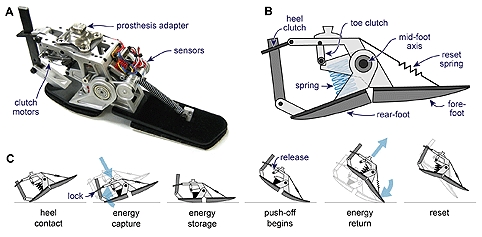Co-developer of the artificial foot, Art Kuo, a biomedical engineering professor at the University of Michigan, explained that, when trying to walk normally, amputees experience what a healthy person would feel if they were carrying an extra 13kg.
The artificial-foot prototype, compared to conventional prosthetic feet, significantly cuts the energy spent per step.
The human walking gait naturally wastes energy as each foot collides with the ground in between steps.
A typical prosthesis doesn’t reproduce the force a living ankle exerts to push off of the ground. As a result, the researchers found that test subjects spent 23 per cent more energy walking with a conventional prosthetic foot, compared with walking naturally.
To see how stepping with their device compared with normal walking, Kuo and his engineering team conducted their experiments with non-amputees wearing a rigid boot and prosthetic simulator.
With the energy-recycling foot, a microcontroller was used to release wasted walking energy at the exact moment power was need to push the ankle.
Based on metabolic rate measurements, the test subjects spent 14 per cent more energy walking in the energy-recycling artificial foot than they did walking naturally. Kuo claimed that that is a significant decrease from the 23 per cent more energy they used in the conventional prosthetic foot.
He explained that all prosthetic feet store and return energy, but they don’t give a choice about when and how.
Kuo said: ‘This is the first device to release the energy in the right way to supplement push off and to do so without an external power source.’

Other devices that boost push-off power use motors and require large batteries. However, Kuo’s energy-recycling foot takes advantage of power that would otherwise be lost, so it uses less than 1W of electricity through a small, portable battery.
Co-developer Steve Collins, who is a Michigan graduate, said the artificial foot could particularly benefit Iraq and Afghanistan war amputees.
‘Individuals with lower limb amputations, such as veterans of the conflicts in Iraq and Afghanistan or patients suffering from diabetes, often find walking a difficult task,’ said Collins, who is now an associate research fellow at Delft University of Technology in the Netherlands.
‘Our new design may restore function and reduce effort for these users. With further progress, robotic limbs may yet beat their biological forerunners.’
The foot is now being tested on amputees at the Seattle Veterans Affairs Medical Center. Commercial devices based on the technology are under development by an Ann Arbor company.
This research was funded by the National Institutes of Health and the Department of Veterans Affairs.




Red Bull makes hydrogen fuel cell play with AVL
Formula 1 is an anachronistic anomaly where its only cutting edge is in engine development. The rules prohibit any real innovation and there would be...